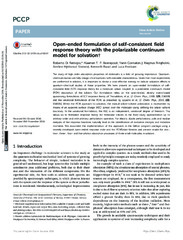| dc.contributor.author | Di Remigio, Roberto | |
| dc.contributor.author | Beerepoot, Maarten | |
| dc.contributor.author | Cornaton, Yann | |
| dc.contributor.author | Ringholm, Magnus | |
| dc.contributor.author | Steindal, Arnfinn Hykkerud | |
| dc.contributor.author | Ruud, Kenneth | |
| dc.contributor.author | Frediani, Luca | |
| dc.date.accessioned | 2017-03-29T13:37:32Z | |
| dc.date.available | 2017-03-29T13:37:32Z | |
| dc.date.issued | 2016-11-15 | |
| dc.description.abstract | The study of high-order absorption properties of molecules is a field of growing importance. Quantumchemical
studies can help design chromophores with desirable characteristics. Given that most experiments
are performed in solution, it is important to devise a cost-effective strategy to include solvation effects in
quantum-chemical studies of these properties. We here present an open-ended formulation of selfconsistent
field (SCF) response theory for a molecular solute coupled to a polarizable continuum model
(PCM) description of the solvent. Our formulation relies on the open-ended, density matrix-based
quasienergy formulation of SCF response theory of Thorvaldsen, et al., [J. Chem. Phys., 2008, 129, 214108]
and the variational formulation of the PCM, as presented by Lipparini et al., [J. Chem. Phys., 2010, 133,
014106]. Within the PCM approach to solvation, the mutual solute–solvent polarization is represented by
means of an apparent surface charge (ASC) spread over the molecular cavity defining the solute–solvent
boundary. In the variational formulation, the ASC is an independent, variational degree of freedom. This
allows us to formulate response theory for molecular solutes in the fixed-cavity approximation up to
arbitrary order and with arbitrary perturbation operators. For electric dipole perturbations, pole and residue
analyses of the response functions naturally lead to the identification of excitation energies and transition
moments. We document the implementation of this approach in the Dalton program package using a
recently developed open-ended response code and the PCMSolver libraries and present results for one-,
two-, three-, four- and five-photon absorption processes of three small molecules in solution. | en_US |
| dc.description.sponsorship | The authors
acknowledge support from the Research Council of Norway
through a Centre of Excellence Grant (Grant No. 179568/V30), from
the European Research Council through a Starting Grant (Grant
No. 279619) and from the Norwegian Supercomputer Program
through a grant for computer time (Grant No. NN4654K). A. H. S.
acknowledges financial support from Tromsø Forskningsstiftelse
(SurfInt grant) | en_US |
| dc.description | Published version. Source at <a href=http://doi.org/10.1039/C6CP06814F>http://doi.org/10.1039/C6CP06814F</a>. License – <a href= https://creativecommons.org/licenses/by/3.0/>CC BY 3.0</a>. | en_US |
| dc.identifier.citation | Phys. Chem. Chem. Phys., 2017,19, 366-379 | en_US |
| dc.identifier.cristinID | FRIDAID 1407184 | |
| dc.identifier.doi | 10.1039/C6CP06814F | |
| dc.identifier.issn | 1463-9084 | |
| dc.identifier.issn | 1463-9076 | |
| dc.identifier.uri | https://hdl.handle.net/10037/10892 | |
| dc.language.iso | eng | en_US |
| dc.publisher | Royal Society of Chemistry | en_US |
| dc.relation.projectID | info:eu-repo/grantAgreement/RCN/FundingProgram/179568/Norway/// | en_US |
| dc.relation.projectID | info:eu-repo/grantAgreement/EC/FundingProgram/279619/EU/// | en_US |
| dc.rights.accessRights | openAccess | en_US |
| dc.subject | VDP::Matematikk og Naturvitenskap: 400::Kjemi: 440 | en_US |
| dc.subject | VDP::Mathematics and natural science: 400::Chemistry: 440 | en_US |
| dc.title | Open-ended formulation of self-consistent field response theory with the polarizable continuum model for solvation | en_US |
| dc.type | Journal article | en_US |
| dc.type | Tidsskriftartikkel | en_US |
| dc.type | Peer reviewed | en_US |


 English
English norsk
norsk